Introduction: Everest Base Camp Trekking
Experience the splendors of the Everest region with our exclusive Everest base camp, located in the Sagarmatha National Park, Nepal, near the border between Nepal and Tibet. Nestled amidst the stunning Himalayan landscape, Everest Base Camp serves as the starting point for trekkers and mountaineers heading towards the iconic Mount Everest. The trek begins with the Kathmandu to Lukla flight following the trekfrom Phakding to Namche Bazaar.
Taking in the breathtaking scenery of Sagarmatha National Park, a UNESCO World Heritage Site, guarantees that you will see some of the most stunning scenery on earth, as it is home to a wide variety of plants and animals. Trekking across high-altitude terrain, charming villages, and verdant rhododendron forests provides a singular and enlightening experience within this protected region.
There are numerous visible mountains in the Everest region, which will make you feel like you are in a sea of hills and mountains. Mt. Kushum Khang, Mt. Everest, Mt. Lhotse, Mt. Cho Oyu, Mt. Nuptse, Mt. Pumori, Mt. Ama Dablam, Mt. Thamserku, Taboche, Cholatse, and many more are among the noteworthy snow-capped peaks that can be seen along the Everest base camp hiking path.
Visit the well-known Tengboche and Pangboche monasteries to get a sense of the region's rich culture. Your walk will gain a cultural component from visiting these old monastic sites, which offer insights into the spiritual practices of the nearby Sherpa people. To help you acclimate to the altitude and ensure a safer and more pleasurable hike, our program includes carefully planned acclimatization days. Engage in local customs and culture during these pauses as our knowledgeable guides give insights into Sherpa traditions, enhancing your trek's cultural richness in addition to its physical rewards.
Our all-inclusive trek package comes with all the permits needed for the trek. Furthermore, we put your safety first by securing dependable travel insurance from our dependable partner, so you can concentrate on the adventure while we handle the details. We recognize the value of ensuring that all adventure seekers can reach Everest Base Camp. Our trek package provides excellent services at a reasonable price without sacrificing them. We put your comfort first while keeping the cost of the trek reasonable, from lodging to food while on the hike.
The short and easy Everest base camp trek itinerary is designed for people who are short on time and want a short yet rewarding experience. The 14-day trip to Everest Base Camp requires you to be fearless and push yourself to the limit. This trip also has numerous health benefits. With our amiable and trustworthy crew, make your way into the Himalayan wilderness. We'll make sure your Everest base camp hike with us is safe and unforgettable.
With Nature Excursion, feel a once-in-a-lifetime adventure to experience the beauty of Everest. In addition to a thrilling mountain experience, our Everest Base Camp Short Trek guarantees a comprehensive experience that will leave you with priceless memories.
What can you expect on an easy and comfortable Everest Base Camp trek?
Trekkers who wish to travel towards Everest Base Camp will witness the grandeur of nature. The easy and comfortable Everest Base Camp trek will cherish fellow travelers with the mesmerizing view of majestic mountain peaks including Mount Everest, Lhotse, Makalu, Cho Oyu, Khumbu Yui Lha, Ama Dablam, Mera Peak, Imja Tse, Ombigaichan, Lobuche, Kusum Kanguru, Kongde Ri, Chhukung Ri, and others.
Similarly, there are various monasteries and stupas located on the Everest Base Camp route. The famous and supposedly oldest monastery in the Khumbu region, which is called the Tengboche monastery, is located here. Pangboche Monastery is another such monastery that has both religious and cultural importance. Exploring such architectural masterclasses will provide evidence for the rich heritage the Everest region holds. Participating in meditation or prayers will rejuvenate any individual and bring about a sense of mindfulness and personal growth, with blessings from the monks and nuns who reside in these monasteries.
Likewise, visitors can get a chance to communicate with the Sherpa people. The Sherpa community dominates Everest, and they offer exceptional hospitality to visitors. Traditional dances, masked performances, and music can be seen during the festive times, giving insights into the culture of the Sherpas.
The Sagarmatha National Park, located in the Everest region, is also another highlight of the trip. This protected area is home to some of Nepal’s most exotic, rare, and endangered flora and fauna. The top attractions of Sagarmatha National Park are the animals, which include the Snow Leopard, Red Panda, Musk Deer, Himalayan Tahr, Himalayan Goral, Himalayan Wolf, and Himalayan Marmot. The national bird of Nepal, which is the Himalayan Monal, is also found here. The comfortable Everest Base Camp is the perfect destination for nature lovers and wildlife enthusiasts.
The sunrise or sunset view from the Kalapatthar is one of the best-capturing sights in the Khumbu region. Kalapatthar provides a 360-degree view of the Himalayan range of Nepal, which is not to be missed. The Khumbu Glacier, which is the biggest glacier in the Khumbu region, can also be seen from Kalapatthar. As the trek is carried out easily and comfortably, trekkers of moderate fitness can do this trek.
The trek mostly begins early in the morning with breakfast at the accommodation. Then the journey continues by gradually moving to a higher altitude. The maximum elevation reached in the Easy Everest Base Camp trek is 5,545 meters. Trekkers will walk across rugged terrain and steep uphill while passing through waterfalls, rivers, suspension bridges, and glaciers. Lunch is served along the route, while dinner is mostly at the place of rest.
Who can do the Everest Base Camp trek?
16-day Everest Base Camp Easy and comfortable trekking is considered a moderately difficult trek. Any person with a moderate fitness level can head to the Everest Base Camp without difficulty. However, engaging in cardiovascular exercises like cycling, running, jogging, swimming, and walking can greatly enhance the experience. It is recommended to make minor changes in the daily habits of those who wish to visit Everest Base Camp. The changes can include omitting lifts, taking the stairs, and walking for at least 45 minutes for a month before starting the trek.
As mentioned, the Everest base camp trek is an easy and comfortable journey. Individuals who intend to walk alone, with friends, or in groups with families and children can accomplish this. The Everest Base Camp journey will not disappoint anyone who wants to lie in the lap of the Himalayas or get close to nature.
Similarly, trekkers with prior experience in the mountain region can easily complete this trek. Those who are familiar with high-altitude trekking and have already gained experience in acclimatization can do this trek with minimum difficulty. However, those who are completely new to trekking might feel this trip is challenging. Walking at higher altitudes needs proper adaptation to the decreased oxygen level, so proper guidance is required to carry out the acclimatization procedure. We at Nature Excursion Pvt. Ltd. have guides who are skilled at handling beginners as well as experienced trekkers, followed by proper acclimatization techniques.
What is the necessary preparation before the trek?
For Everest Base Camp's easy trek, meticulous planning is necessary. Physical and mental fitness are a must, even though Everest base camp trekking is considered a moderately difficult trek. Hiking the rugged terrain along the glaciers with steep uphill slopes can be a challenge. So effective planning is necessary. Some of the following points encompass the requirement for preparation before heading towards the base camp of Everest.
Physical fitness: A moderate fitness level should be maintained one month before the trek. It is necessary to engage in cardiovascular exercises like jogging, cycling, running, and swimming so that the journey will be relatively easy. Some aerobic workouts and walking for at least an hour per day can enhance the ability to walk on steep slopes. Strong legs are the key to easy trekking, so practice exercise focusing on the leg muscles. Similarly, omitting lifts, preferring stairs, and researching the terrain can help get insights into what to encounter during the Everest base camp route.
Mental fitness: besides physical fitness, one needs to be mentally prepared to embark on the base camp. As the region is at a high altitude, hiking in the isolated region can put pressure on the mentality. Irritation during the trek is a common problem, so it is necessary to keep an open mind and adjust to minor changes. Accommodation options, food, poor communication, and electricity facilities can be a big deal. Besides this, the challenging trekking routes and lack of communication skills can bother any individual. So, it is necessary to do some research about the landscapes, terrains, and local communities of the area before going on the trek. This will make any individual familiar with how the region is and what can be expected.
Considering altitude, the highest altitude reached in the Everest Base Camp is Kalapatthar, 5545 meters. So, acclimatization is an important factor in counteracting acute mountain sickness or altitude sickness. Take the steps cautiously without rushing to reach the top. Smaller steps, while considering the energy level and elevation gain, are a must. During the acclimatization day, be sure to gain a significant amount of elevation and return to adapt to the high altitude and decreased oxygen level.
What do you need to pack for the trek?
Packing the equipment, gear, and all the necessary belongings is necessary for a comfortable Everest base camp trek. Be sure to pack all your belongings according to your needs. Packing heavy or light can greatly affect the trekking experience. Overpacking can cause difficulty while walking and discomfort while packing. You can miss out on any essential materials that are of utmost importance. So, it is necessary to follow the packing list prepared by Nature Excursion Pvt. Ltd. to not miss any of the essential kinds of stuff for trekking.
Similarly, good-quality trekking boots, sleeping bags, down jackets, and trekking bags should be packed without missing anything. Be sure to carry water bottles that can carry at least 4-5 liters of water, which will keep you hydrated on the journey. Similarly, dry fruits, energy bars, or other foods can also be kept as a source of energy for the trip. Any individual who has to take medicine should bring a prescription, as similar medicines might not be available. For ladies and women, be sure to carry extra sanitary pads.
Ready for the experience?
The Himalayan region of Nepal is a memorable destination that is going to cherish all its visitors with all their mountain memories. The rich Sherpa heritage and hospitality will be one of the most unique blends of adventure and culture that the Everest region has to offer. Easy Trekking in Everest Base Camp will allow anyone to immerse themselves in the Nepalese-rich mountaineering culture. The difficulty of this trek will challenge any trekker. As this is an easy and comfortable trek, it is suitable for beginners, intermediates, and hardcore trekkers. Alongside this, Nature Excursion Pvt. Ltd., one of the renowned trekking companies in Nepal, values trekkers satisfaction, comfort, and safety. So, we will best cooperate with our fellow travelers to provide exceptional service that will be noteworthy.
Similarly, as trekkers get to Kathmandu, a scenic flight from the capital to Lukla awaits, where passengers will get a bird's-eye view of the landscapes and mountain ranges on which they will soon embark. The rivers, glaciers, and waterfalls along the rugged terrain offer an additional touch of beauty to the trekking experience. A magnificent sunset or sunrise view from the highest altitude (5545 meters) of the trek known as Kalapatthar is also included in this 16-day Everest Base Camp Easy and Comfortable Trekking Package.
Similarly, get a chance to view the Khumbu Glacier, the biggest glacier in the region, and the Khumbu Icefall with our expert guides and porters. Traverse along the Sagarmatha National Park with a chance to encounter various wildlife species, including the Red Panda, Himalayan Thar, Himalayan Monal, Musk Deer, and many more.
So come together with Nature Excursion to get immersed in the rich cultural and religious history of the Khumbu region with the Sherpa community. This memorable trek will be off your bucket list, and we are ready to assist you on an easy and comfortable trek towards the Everest base camp.
Why the Everest Base Camp trip with Nature Excursion?
Our team at Nature Excursion Pvt. Ltd. has been providing trekking services to our valuable guests for a long time. Our experienced guides and reliable porters are native to their trekking region. Thus, this gives them an upper hand in understanding the culture, traditions, and structures of the region. The guides are informative and enable trekkers to travel in a comfortable manner, feeling at home. The interactive and reliable nature ensures an easy and safe journey, thus minimizing the risk of any unforeseen circumstances.
Despite the trekking experience, there are various perks to traveling with Nature Excursion. They are given as follows:
- Complimentary airport transportation according to the schedule.
- Obtain hiking equipment for the trip, such as a duffel bag and down jacket, which should be returned at the conclusion of the expedition.
- Using a first-aid kit and an oxygen meter when hiking.
- Local porters and guides for mountains
- spick and span with well-prepared meals.
- Trek certificate and t-shirt from Nature Excursion.
- During the walk in the remote areas, use the satellite phone to communicate with the office staff.
- In Kathmandu, extra luggage storage is free.
- In the event of an emergency, we will offer you rapid helicopter rescue and medical support (at your travel insurance company's expense).
- Farewell meal at the end of the journey.
Despite all the above-mentioned services, there are no hidden costs while trekking at the Everest Base Camp with Nature Excursion. We believe in budget-friendly trekking, where every individual will be able to explore the magical country of Nepal without fear of expense. So join hands with Nature Excursion to immerse yourself at the top of the world in a once-in-a-lifetime experience.



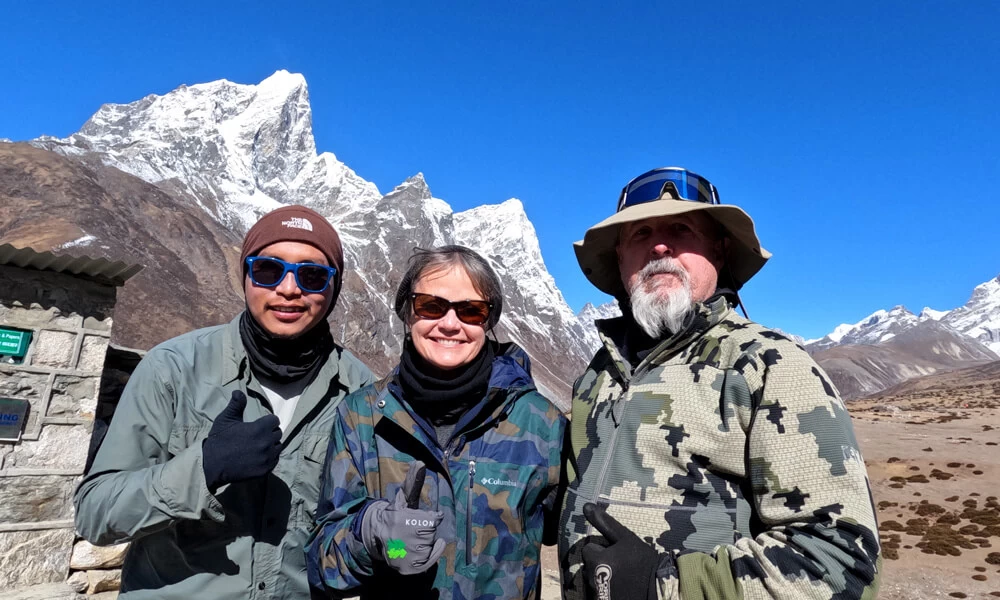
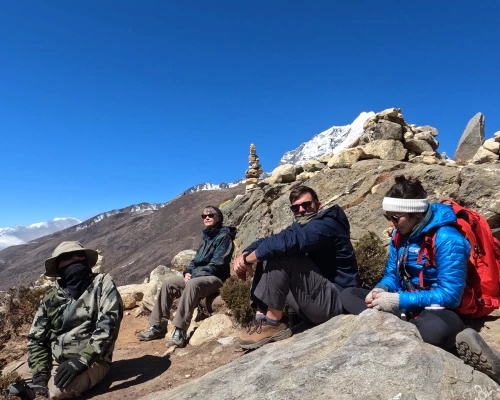
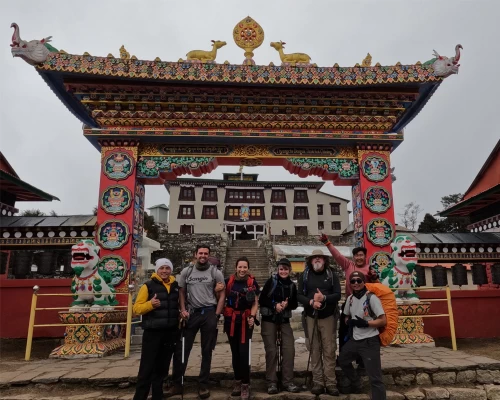
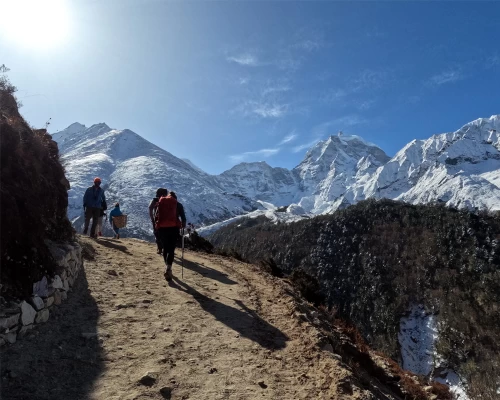
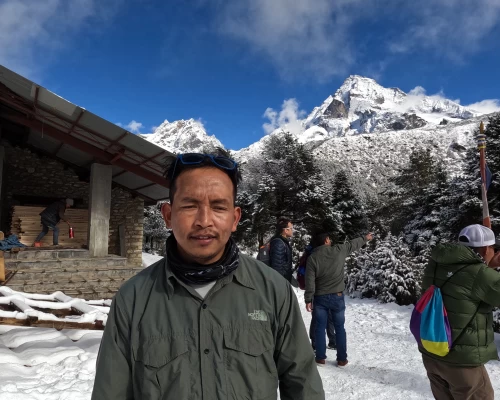

-(1).webp)

.webp)
.webp)